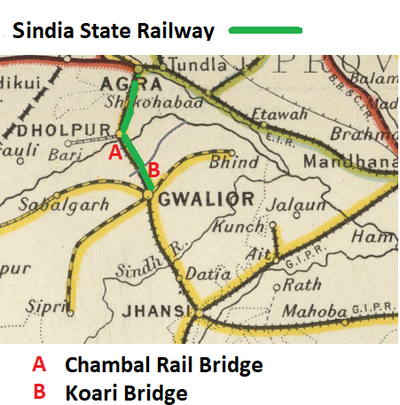Koari Bridge: Difference between revisions
mNo edit summary |
mNo edit summary |
||
| Line 1: | Line 1: | ||
<big>'''Koari Bridge'''</big> | <big>'''Koari Bridge'''</big> | ||
[[File: | [[File:Sindia State Railway 1.png|right|400px|'''Koari Bridge''']] | ||
It was recorded that <ref name=ICE1916>[https://www.icevirtuallibrary.com/doi/abs/10.1680/imotp.1916.15918 Minutes of the Proceedings of the Institution of Civil Engineers, Volume 202 Issue 1916, pp. 371-377 ‘The Reconstruction of the Koari Bridge, GIPR’ by T C Hood]; Retrieved 28 Nov 2020</ref>:- | It was recorded that <ref name=ICE1916>[https://www.icevirtuallibrary.com/doi/abs/10.1680/imotp.1916.15918 Minutes of the Proceedings of the Institution of Civil Engineers, Volume 202 Issue 1916, pp. 371-377 ‘The Reconstruction of the Koari Bridge, GIPR’ by T C Hood]; Retrieved 28 Nov 2020</ref>:- | ||
<blockquote>“The Kaori River, a tributary of the Chambal River, is crossed by the main line of the Great Indian Peninsula Railway, 788 miles from Bombay in the territory of the Maharajah Scindia of Gwalior. This portion of the line, originally the Scindia State Railway, was merged in the Inland Midland Railway, and ultimately became part of the Great Indian Peninsula Railway system.” </blockquote>. | <blockquote>“The Kaori River, a tributary of the Chambal River, is crossed by the main line of the Great Indian Peninsula Railway, 788 miles from Bombay in the territory of the Maharajah Scindia of Gwalior. This portion of the line, originally the Scindia State Railway, was merged in the Inland Midland Railway, and ultimately became part of the Great Indian Peninsula Railway system.” </blockquote>. | ||
| Line 8: | Line 8: | ||
==The Bridge== | ==The Bridge== | ||
The bridge was built in 1880 by the ‘[[ | The bridge was built in 1880 by the ‘[[Sindia State Railway]]’, which was merged into the ‘[[Indian Midland Railway]]’, and ultimately became part of the ‘[[Great Indian Peninsula Railway]]’. The bridge consisted of three spans of 100 foot (30.5mtr) clear with a 40 foot (12.2mtr) opening at each end. The structure carried a single broad gauge([[Rail_gauge#Broad_Gauge|BG]]) track and was of wrought-iron, the 40 foot spans of plate-girder type and 100 foot spans of Warren type main girders 105 foot long <ref name=ICE1916/>. | ||
==Further Information== | ==Further Information== | ||
Up to 1885 see '''[[ | Up to 1885 see '''[[Sindia State Railway]]''' | ||
<br>1885 to 1900 see '''[[Indian Midland Railway]]''' | <br>1885 to 1900 see '''[[Indian Midland Railway]]''' | ||
<br>From 1900 see '''[[Great Indian Peninsula Railway]]''' | <br>From 1900 see '''[[Great Indian Peninsula Railway]]''' | ||
Latest revision as of 10:18, 29 November 2020
Koari Bridge

It was recorded that [1]:-
“The Kaori River, a tributary of the Chambal River, is crossed by the main line of the Great Indian Peninsula Railway, 788 miles from Bombay in the territory of the Maharajah Scindia of Gwalior. This portion of the line, originally the Scindia State Railway, was merged in the Inland Midland Railway, and ultimately became part of the Great Indian Peninsula Railway system.”
.
It has not been possible to positively determine this River and the Bridge. From the description it would be about 25 miles(40km) north from Gwalior in the direction of Dholpur. Showing as Asan River on modern maps ,the railway bridge is at the head of the Kotwai Reservoir and a short distance south of Morena.
On this basis we have marked the position B on the map.
The Bridge
The bridge was built in 1880 by the ‘Sindia State Railway’, which was merged into the ‘Indian Midland Railway’, and ultimately became part of the ‘Great Indian Peninsula Railway’. The bridge consisted of three spans of 100 foot (30.5mtr) clear with a 40 foot (12.2mtr) opening at each end. The structure carried a single broad gauge(BG) track and was of wrought-iron, the 40 foot spans of plate-girder type and 100 foot spans of Warren type main girders 105 foot long [1].
Further Information
Up to 1885 see Sindia State Railway
1885 to 1900 see Indian Midland Railway
From 1900 see Great Indian Peninsula Railway